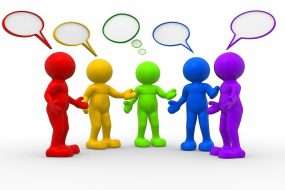
In the realm of communication, words are not always the sole conveyors of messages. Non-verbal communication, consisting of gestures, facial expressions, body language, and other non-linguistic cues, plays a significant role in human interaction. Understanding and effectively utilizing non-verbal communication can enhance our ability to connect, express ourselves, and build meaningful relationships. In this article, we will delve into the power of non-verbal communication, explore its various forms, and provide insights on how to leverage this essential skill in different contexts.
The Silent Language: Unveiling the Power of Non-Verbal Communication
Non-verbal communication is a silent language that speaks volumes. It goes beyond the spoken word, allowing us to express emotions, attitudes, and intentions in ways that words alone cannot capture. Harnessing the power of non-verbal communication enables us to create rapport, establish trust, and convey messages with precision and depth.
Forms of Non-Verbal Communication
1. Facial Expressions: Windows to the Soul
The human face is a canvas of emotions, with countless microexpressions revealing our true feelings. Smiles, frowns, raised eyebrows, and narrowed eyes are just a few examples of how facial expressions can communicate happiness, sadness, surprise, and various other emotions. Mastering the art of interpreting and displaying facial expressions allows for more nuanced and empathetic communication.
2. Body Language: The Unspoken Movement
Our bodies have a language of their own, speaking through postures, gestures, and movements. A firm handshake, open arms, or crossed legs can convey confidence, openness, or defensiveness. Paying attention to body language and consciously utilizing it can help convey our messages more effectively and project a desired image.
3. Proxemics: The Space Between Us
The way we use and respond to personal space differs across cultures and individuals. Proxemics refers to the study of spatial relationships and how they influence communication. Understanding the appropriate proximity in different contexts, be it intimate, personal, social, or public, allows us to navigate social interactions with respect and consideration.
4. Eye Contact: The Window of Connection
The eyes are often referred to as the window to the soul, and maintaining appropriate eye contact is a powerful non-verbal communication tool. It conveys interest, attentiveness, and sincerity. However, it's essential to be mindful of cultural norms and individual comfort levels, as eye contact practices can vary across different contexts.
5. Vocal Cues: Tone, Pitch, and Pace
While non-verbal communication predominantly focuses on the non-linguistic aspects, vocal cues are an important component. Tone, pitch, and pace of speech can convey emotions, emphasis, and meaning. By consciously modulating these vocal elements, we can add depth and clarity to our verbal communication.
5 FAQs about Utilizing Non-Verbal Communication
Q1: How can non-verbal communication enhance interpersonal relationships?
Non-verbal communication allows us to connect on a deeper level, build rapport, and establish trust. It helps us understand others' emotions, intentions, and attitudes, fostering stronger interpersonal relationships.
Q2: Can non-verbal communication be misunderstood?
Yes, non-verbal communication can be subjective and open to interpretation. It's crucial to consider cultural differences, individual preferences, and context when interpreting and utilizing non-verbal cues.
Q3: Are there universal non-verbal communication cues?
While some non-verbal cues, such as facial expressions for basic emotions,
are universal, others can vary across cultures. It's essential to be aware of cultural norms and adapt our non-verbal communication accordingly.
Q4: How can non-verbal communication be utilized in professional settings?
In professional settings, non-verbal communication can enhance presentations, negotiations, and networking. It helps convey confidence, credibility, and engagement, reinforcing the effectiveness of verbal messages.
Q5: Can non-verbal communication be learned and improved?
Absolutely! Like any skill, non-verbal communication can be learned and refined through practice, observation, and self-awareness. By studying and consciously utilizing non-verbal cues, we can become more effective communicators.
Conclusion
Non-verbal communication is an invaluable tool in our communication repertoire. By honing our understanding and utilization of facial expressions, body language, proxemics, eye contact, and vocal cues, we can enrich our interactions, strengthen relationships, and convey messages with greater impact. Embrace the power of non-verbal communication, and unlock new dimensions of connection and understanding in your personal and professional interactions.











